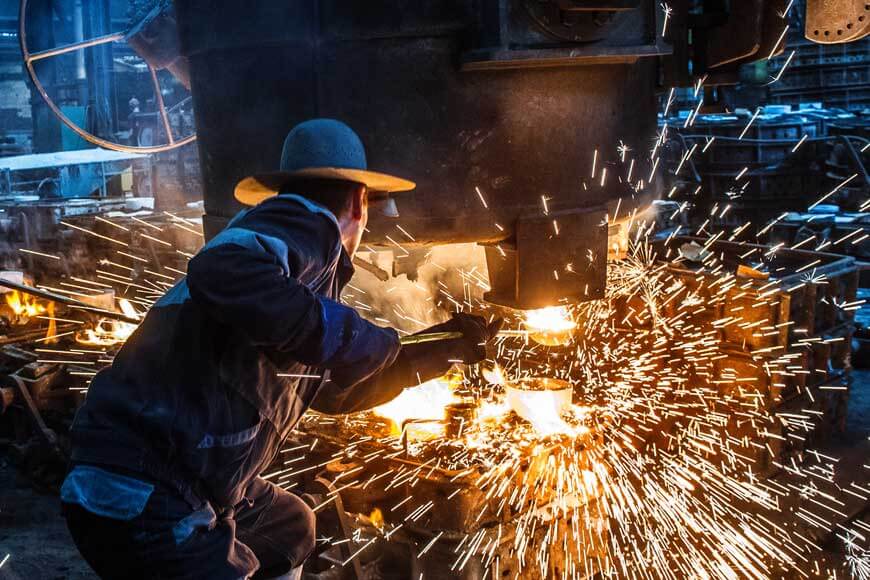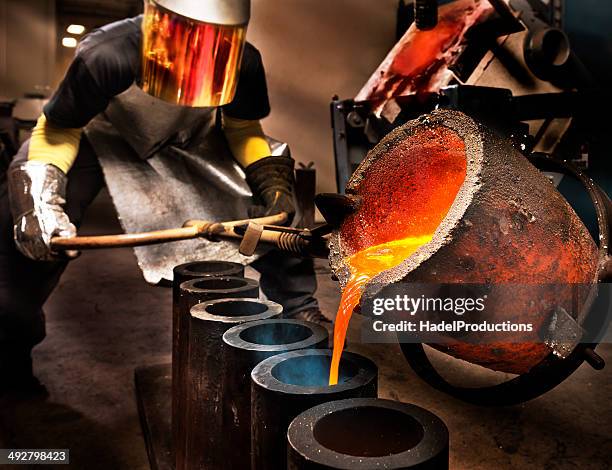Everything About Metal Casting: Exactly How Foundries Deliver Quality and Precision in Production
Metal casting stands as a fundamental process in manufacturing, where raw metals are changed right into specific components. Foundries use numerous casting approaches to accomplish desired characteristics and forms. Each approach includes its very own collection of restrictions and advantages. Understanding these subtleties is vital for appreciating how high quality and precision are maintained throughout the procedure. The discussion in advance will check out the elaborate dynamics of metal casting and its significance across several industries.
The Essentials of Metal Casting
Metal casting is an essential process in making that involves forming liquified metal right into preferred types. This important method begins with the option of basic materials, often different metal alloys, which are thawed in a furnace. As soon as the metal reaches the proper temperature level, it becomes fluid and all set for casting.
The procedure calls for a mold and mildew, usually made from sand, metal, or ceramic, which specifies the final shape of the actors things. Once the liquified metal is put right into the mold and mildew, it cools and solidifies, taking on the mold and mildew's contours.
After cooling down, the casting is gotten rid of from the mold, and any type of needed completing procedures, such as brightening or trimming, are carried out. This approach permits manufacturers to generate intricate shapes and elements with high precision and very little waste. Metal casting is extensively used throughout different industries, from automobile to aerospace, underscoring its value in contemporary production.
Kinds Of Casting Methods
While numerous casting techniques exist, each strategy provides unique advantages and is fit for different applications. Sand casting, one of the most usual techniques, makes use of sand as the mold and mildew material, permitting big parts and complex layouts. Investment casting, recognized for its precision, utilizes a wax pattern coated in ceramic, making it optimal for complicated geometries. Die casting, which includes requiring molten metal into mold and mildews under high pressure, is frequently utilized for mass manufacturing of little, in-depth elements. Furthermore, shell molding combines sand and resin to produce thinner, much more accurate mold and mildews, boosting surface area coating. One more approach, constant casting, enables the production of lengthy lengths of metal forms, improving manufacturing processes. Each of these techniques plays an essential duty in the metal casting market, dealing with specific requirements from production quantity to develop intricacy, thus adding to the variety of applications across numerous markets.
The Duty of Foundries in Production
Foundries serve a vital function in the production landscape, as they change raw steels into usable elements via various casting procedures. These facilities use a variety of strategies to develop products that fulfill precise specs, thus making certain quality and efficiency in manufacturing (Metal Foundry). By using techniques such as sand casting, investment casting, and die casting, factories cater to diverse sectors, consisting of vehicle, aerospace, and construction

Ultimately, factories are integral to the production community, supplying crucial parts that sustain a wide array of industries and applications. Their precision and versatility drive performance in modern production.
Materials Made Use Of in Metal Casting
The selection of products utilized in metal casting is important for accomplishing the wanted homes and performance of the end product. Numerous steels such as aluminum, bronze, and iron are commonly utilized, each offering distinctive advantages. Aluminum is favored for its corrosion-resistant and light-weight top qualities, making it excellent for automotive and aerospace applications. Iron, especially cast iron, is known for its excellent fluidity and toughness, suitable for hefty machinery and facilities parts. Bronze, with its exceptional wear resistance, is frequently made use of in marine atmospheres.
Additionally, products such as silica sand are frequently used for mold production, supplying a great equilibrium in between resilience and ease of shaping. The choice of products additionally consists of additives like changes, which improve the casting process by improving fluidness and decreasing oxidation. Eventually, the ideal selection of these materials greatly influences the effectiveness and high quality of the casting procedure.
Top quality Control in the Casting Process
Quality control in the casting process is important to ensure that end products satisfy market requirements and specs. Various evaluation techniques are utilized to recognize defects and evaluate the integrity of actors elements. Furthermore, adherence to established standards and accreditations boosts the dependability and efficiency of cast materials.
Evaluation Techniques Employed
Preserving the stability of actors metal components depends heavily on various assessment strategies. Foundries employ visual inspections as a preliminary action to recognize surface area defects, such as incorporations or cracks. Non-destructive testing (NDT) approaches, consisting of ultrasonic screening and radiographic evaluation, are important for finding inner defects without compromising the part's honesty. Dimensional assessments making use of calipers and coordinate measuring devices verify that components satisfy specified resistances. Additionally, chemical analysis confirms that the alloy composition straightens with called for requirements. These evaluation strategies collectively verify that the spreadings meet the essential quality and performance standards, eventually minimizing the danger of failure in their intended applications. Implementing these extensive evaluations is essential for preserving high requirements in metal casting production.
Requirements and Certifications
Specifications and qualifications play an essential duty in the top quality control of the casting procedure. Foundries stick to numerous international and industry-specific criteria, such as ISO 9001 and ASTM guidelines, assuring consistency and integrity in their products. These criteria outline the required requirements for products, production methods, and screening procedures, adding to a more reliable production procedure. Accreditations, such as AS9100 for aerospace applications, even more emphasize the importance of quality control in specialized sectors. By acquiring these credentials, factories show their commitment to excellence, decreasing flaws and improving customer complete satisfaction. Normal audits and assessments verify compliance, fostering continual enhancement and innovation within the sector. Ultimately, adherence to established requirements cultivates trust between suppliers and clients.
Developments in Casting Technology

3D Printing Combination
Incorporating 3D printing modern technology right into metal casting procedures is revolutionizing the manufacturing landscape. This cutting-edge combination enhances the layout and production of complex geometries that standard techniques struggle to achieve. By utilizing additive manufacturing for creating mold and mildews and cores, factories can significantly decrease preparations and product waste. 3D printing allows for fast prototyping, making it possible for suppliers to check designs rapidly and efficiently, thereby facilitating iterative enhancements. This innovation additionally supports the manufacturing of light-weight parts, which are vital in sectors such as aerospace and vehicle. Therefore, the combination of 3D printing not just streamlines procedures yet also raises the precision and high quality of cast metal items, marking a notable improvement in the sector.
Automated Production Processes
The advancements in 3D printing have led the way for additional innovations in computerized manufacturing procedures within metal casting. Foundries are increasingly taking on robotics and automation to improve performance and precision. Automated systems enhance the whole casting workflow, from mold and mildew development to pouring and ending up. Smart sensors and real-time tracking enable exact control of temperatures and product circulation, decreasing waste and improving top quality. Furthermore, software solutions facilitate better layout and simulation, enabling suppliers to optimize procedures prior to manufacturing begins. These computerized production procedures not just lower labor costs however likewise decrease human error, making certain consistent outcome. Consequently, Aluminum Foundry the assimilation of innovative technologies in metal casting is reinventing manufacturing capabilities and satisfying the growing demands of various markets.
Advanced Product Advancement
As markets demand higher performance and sustainability, innovations in material development for metal casting are arising as a crucial focus. Researchers and engineers are discovering new alloys and compounds that improve mechanical properties while decreasing ecological influence. Advancements consist of lightweight materials that preserve stamina, making it possible for better gas effectiveness in transportation applications. Additionally, the consolidation of recycled materials is ending up being much more widespread, straightening with sustainability objectives. Advanced casting techniques, such as 3D printing and precision molding, permit for the development of intricate geometries that traditional techniques can not accomplish. These advancements not just improve the functionality of actors components but likewise boost manufacturing efficiency. In general, the constant advancement of product science drives the future of metal casting, fulfilling the demands of modern-day industries.
Applications of Metal Casting Across Industries
Metal casting plays a vital function in numerous markets, as it permits for the manufacturing of complicated shapes and top notch elements with loved one effectiveness - Aluminum Foundry. In the automotive field, cast steels are vital for creating engine blocks, transmission cases, and various other crucial parts that require sturdiness and precision. Aerospace industries use metal casting for parts like generator blades and architectural aspects, where reliability is extremely important
Additionally, equipment and devices production gain from metal casting by generating equipments, real estates, and other elaborate components that improve capability. The building and construction sector additionally employs metal casting for architectural functions, structural supports, and fittings, showcasing versatility.
The clinical area counts on cast metals for medical instruments and implants, highlighting the requirement for biocompatibility. Overall, metal casting is a fundamental process throughout multiple industries, supplying remedies that satisfy rigorous high quality requirements and performance demands.
Regularly Asked Questions
What Precaution Are Absorbed Metal Casting Foundries?
In metal casting foundries, safety actions consist of protective gear, air flow systems, normal devices upkeep, worker training, and emergency situation methods to minimize dangers linked with heats, harmful products, and possible mishaps throughout the casting procedure.
Just How Do Foundries Take Care Of Waste and Environmental Influence?
Foundries manage waste and ecological effect via reusing products, carrying out purification systems for exhausts, and adhering to regulations - Metal Foundry. They also embrace sustainable practices, such as decreasing energy consumption and making use of environmentally friendly compounds in their procedures
What Are the Costs Connected With Metal Casting Processes?
The expenses connected with metal casting procedures consist of raw products, labor, tools maintenance, power intake, and waste administration. In addition, changes in market costs and compliance with environmental regulations can substantially influence overall expenses for factories.
Exactly How Does Metal Casting Contrast to Other Production Techniques?
Metal casting offers distinctive advantages, such as intricate forms and high material efficiency, contrasted to methods like machining or marking. However, it might involve much longer lead times and higher first costs, relying on project requirements.
What Occupation Opportunities Exist in the Metal Casting Sector?
The metal casting market uses numerous profession chances, consisting of shop monitoring, procedure design, quality guarantee, mold layout, and maker operation. Experts can likewise pursue functions in research and growth, sales, and ecological wellness and safety and security.
Metal casting stands as a foundational process in manufacturing, where raw metals are transformed right into particular parts. Metal casting is a fundamental procedure in manufacturing that involves shaping liquified metal right into wanted forms. Another method, constant casting, makes it possible for the production of long sizes of metal forms, streamlining manufacturing processes. The prices associated with metal casting processes include raw materials, labor, equipment maintenance, energy consumption, and waste management. The metal casting market uses numerous job possibilities, consisting of shop monitoring, procedure design, high quality guarantee, mold layout, and equipment procedure.